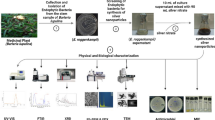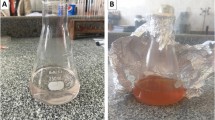Abstract
Herein, we report the antimicrobial efficacy of sodium benzoate-functionalized silver nanoparticles synthesized via a simple method and its potential prospects as food preservatives. Sodium benzoate (SB) is a commonly known food preservative and is capable of reducing the silver salt to silver nanoparticles in high yield under facile conditions. The functionalization of SB imparts enough stability to the nanoparticles to remain dispersed in aqueous solution for long time, without the need of any other additional stabilizing agent. The nanoparticles were characterized using high-performance liquid chromatography (HPLC), atomic force microscopy (AFM), zeta potential, Fourier transform infrared spectroscopy (FT-IR), proton nuclear magnetic resonance (1H-NMR) and UV–visible spectroscopy. In order to explore its role as food preservative, the antimicrobial activity of sodium benzoate-capped silver nanoparticles (SB-SNPs) was tested against various food-borne pathogenic bacteria and the results clearly indicated that the synthesized nanoparticles were highly active against the food pathogen strains even at very low concentrations as compared to sodium benzoate alone.






Similar content being viewed by others
References
Mota FJM, Ferreira IMPLVO, Cunha SC, Beatriz M, Oliveira PP (2003) Optimisation of extraction procedures for analysis of benzoic and sorbic acid in food stuffs. Food Chem 82:469–473
Nair B (2001) Final report on the safety assessment of benzyl alcohol, benzoic acid, and sodium benzoate. Int J Toxicol 20:23–50
Ren L, Meng M, Wang P, Xu Z, Eremin SA, Zhao J, Yin Y, Xi R (2014) Determination of sodium benzoate in food products by fluorescence polarization immunoassay. Talanta 121:136–143
Ethiraj AS, Jayanthi S, Ramalingam C, Banerjee C (2016) Control of size and antimicrobial activity of green synthesized silver nanoparticles. Mater Lett 185:526–529
Cakic M, Glisic S, Nikolic G, Nikolic GM, Cakic K, Cvetinov M (2016) Synthesis, characterization and antimicrobial activity of dextran sulfate stabilized silver nanoparticles. J Mol Struct 1110:156–161
Lopez-Esparza J, Espinosa-Cristobal LF, Donohue-Cornejo A, Reyes-Lopez SY (2016) Antimicrobial activity of silver nanoparticles in polycaprolactone nanofibers against gram-positive and gram-negative bacteria. Ind Eng Chem Res 55:12532–12538
Cushen M, Kerry J, Morris M, Cruz-Romero M, Cummins E (2012) Nanotechnologies in the food industry-recent developments, risks and regulation review article. Trends Food Sci Technol 24:1–60
Bala R, Dhingra S, Kumar M, Bansal K, Mittal S, Sharma RK, Wangoo N (2017) Detection of organophosphorus pesticide—malathion in environmental samples using peptide and aptamer based nanoprobes. Chem Eng J 311:111–116
Zhang and Hongyin (2013) Application of silver nanoparticles in drinking water purification. Open Access Dissertations, Paper 29
Mu H, Tang J, Liu Q, Sun C, Wang T, Duan J (2016) Potent antibacterial nanoparticles against biofilm and intracellular bacteria. Sci Rep 6:18877. doi:10.1038/srep18877
Berekaa MM (2015) Nanotechnology in food Industry; Advances in food processing, packaging and food safety. Int J Current Microbiol Appl Sci 4:345–357
Karimi A, Hayat A, Andreescu S (2017) Biomolecular detection at ssDNA-conjugated nanoparticles by nano-impact electrochemistry. Biosens Bioelectron 87:501–507
Ge L, Li Q, Wang M, Ouyang J, Li X, Xing MM (2014) Nanosilver particles in medical applications: synthesis, performance, and toxicity. Int J Nanomed 9:2399–2407
Larguinho M, Baptista PV (2012) Gold and silver nanoparticles for clinical diagnostics- from genomics to proteomics. J Proteom 75:2811–2823
Dong XY, Gao ZW, Yang KF, Zhang WQL, Xu W (2015) Nanosilver as a new generation of silver catalysts in organic transformations for efficient synthesis of fine chemicals. Catal Sci Technol 5:2554–2574
Raza MA, Kanwal Z, Rauf A, Sabri AN, Riaz S, Naseem S (2016) Size and shape-dependent antibacterial studies of silver nanoparticles synthesized by wet chemical routes. Nanomaterials 6:74
Bakirdere S, Yilmaz MT, Tornuk F, Keyf S, Yilmaz A, Sagdic O, Kocabas B (2015) Molecular characterization of silver–stearate nanoparticles (AgStNPs): a hydrophobic and antimicrobial material against food borne pathogens. Food Res Int 76:439–448
Patel A, Prajapati P, Boghra R (2011) Overview on application of nanoparticles in cosmetics. Asian J Pharm Sci Clin Res 1:40–55
Rivero PJ, Urrutia A, Goicoechea J, Arregui FJ (2015) Nanomaterials for functional textiles and fibers. Nanoscale Res Lett 10:501
M-Monyatsi L, Mthombeni NH, Onyango NS, Momba MNB (2012) Cost-effective filter materials coated with silver nanoparticles for the removal of pathogenic bacteria in groundwater. Int J Environ Res Public Health 9:244–271
Kheiralla ZMH, Rushdy AA, Betiha MA, Yakob NAN (2014) High-performance antibacterial of montmorillonite decorated with silver nanoparticles using microwave assisted method. J Nanopart Res 16:2560
Chernousova S, Epple M (2013) Silver as antibacterial agent: ion, nanoparticle, and metal. Angew Chem Int Ed 52:1636–1653
Ashour SM (2014) Silver nanoparticles as antimicrobial agent from Kluyveromyces marxianus and candida utilis. Int J Curr Microbiol Appl Sci 3:384–396
Valgas C, De Souza SM, Smania EFA, Smania A (2007) Screening methods to determine antibacterial activity of natural products. Braz J Microbiol 38:369–380
Lazarus LL, Riche TC, Malmstadt N, Brutchey LR (2012) Effect of ionic liquid impurities on the synthesis of silver nanoparticles. Langmuir 28:15987–15993
Li C, Li D, Wan G, Xu J, Hou W (2011) Facile synthesis of concentrated gold nanoparticles with low size-distribution in water: temperature and pH controls. Nanoscale Res Lett 6:1–10
Ruparelia JP, Chatterjee AK, Duttagupta SP, Mukherji S (2008) Strain specificity in antimicrobial activity of silver and copper nanoparticles. Acta Biomater 4:707–716
Agnihotri S, Mukherji S, Mukherji S (2014) Size-controlled silver nanoparticles synthesized over the range 5–100 nm using the same protocol and their antibacterial efficacy. RSC Adv 4:3974–3983
Raza MA, Kanwal Z, Rauf A, Sabri AN, Riaz S, Naseem S (2016) Size- and shape-dependent antibacterial studies of silver nanoparticles synthesized by wetc routes. Nanomaterials 6:74
Beyth N, Houri-Haddad Y, Domb A, Khan W, Hazan R (2015) Alternative antimicrobial approach: nano-antimicrobial materials. Evid Based Complement Alternat Med 2015:246012. doi:10.1155/2015/246012
Wu C, Zhou X, Wei J (2015) Localized surface plasmon resonance of silver nanotriangles synthesized by a versatile solution reaction. Nanoscale Res Lett 10:354
Pal S, Tak YK, Song JM (2007) Does the antibacterial activity of silver nanoparticles depend on the shape of the nanoparticle? A study of the Gram-negative bacterium Escherichia coli. Appl Environ Microbiol 73:1712–1720
Bragg PD, Rainnie DJ (1974) The effect of silver ions on the respiratory chains of Escherichia coli. Can J Microbiol 20:883–889
Acknowledgements
This work was supported by the Department of Biotechnology, India, Grant No. BT/PR10460/PFN/20/871/2013 and Science Engineering and Research Board (SERB), India, Grant No. SB/SO/BB/0040/2013. MK thanks SERB for research fellowship.
Author information
Authors and Affiliations
Corresponding author
Rights and permissions
About this article
Cite this article
Kumar, M., Bala, R., Gondil, V.S. et al. Combating food pathogens using sodium benzoate functionalized silver nanoparticles: synthesis, characterization and antimicrobial evaluation. J Mater Sci 52, 8568–8575 (2017). https://doi.org/10.1007/s10853-017-1072-z
Received:
Accepted:
Published:
Issue Date:
DOI: https://doi.org/10.1007/s10853-017-1072-z




